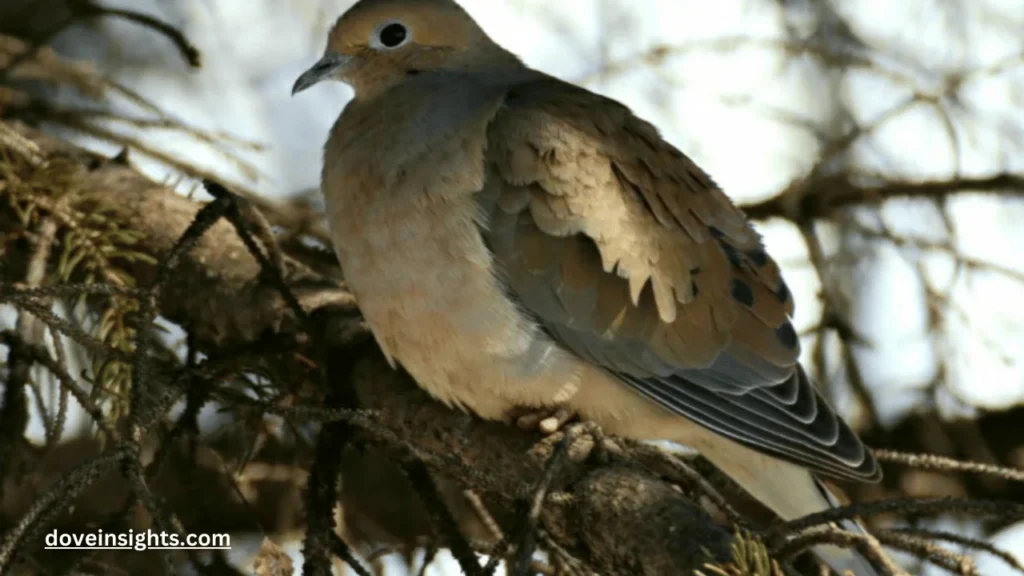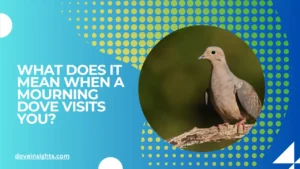If you’ve ever seen a mourning dove perched serenely on a branch, you might have wondered how to draw them closer or even make them feel comfortable around you.
The soft, melodic cooing of these graceful birds evokes feelings of peace, making them a natural symbol of tranquility and hope. But are these wild creatures approachable? Can you befriend them, or are mourning doves too elusive to form a bond with?
Befriending a mourning dove requires more than just patience—it involves understanding their natural behaviors, respecting their space, and creating an environment where they feel safe and comfortable.
While these birds are not typically domesticated, they can form subtle connections with humans if the right approach is taken. In this article, we’ll explore how to build trust with mourning doves, how to provide for their needs, and how to respect their wild instincts while getting closer to them.
Contents
Understanding Mourning Doves: Nature’s Gentle Creatures
Before attempting to befriend a mourning dove, it’s essential to understand their natural behavior and needs. Mourning doves, unlike more domesticated species, are wild animals that have evolved to be cautious and self-reliant.
Their survival instincts make them wary of humans, but with the right approach, they can learn to tolerate your presence.
- Physical Traits and Behavior: Mourning doves are medium-sized birds known for their slender bodies, long tails, and soft grayish-brown feathers. They are known for their distinctive cooing sound, which is primarily used to communicate during mating season or to establish territory.
- Wild Nature: As wild creatures, mourning doves are often seen as skittish and avoidant of human interaction. However, their calm demeanor and ability to thrive in urban and suburban environments make them more accessible than other wild species.
- Communication: Mourning doves communicate through a variety of vocalizations, including coos, whistling sounds, and soft calls that express emotions like fear or contentment. Understanding these signals will help you gauge how the dove is feeling and whether it’s comfortable being around you.
By recognizing and respecting their natural behavior, you can create an environment conducive to forming a bond.
Creating a Dove-Friendly Environment
One of the most important aspects of befriending a mourning dove is providing a safe and welcoming environment. Doves are naturally shy, so any sudden movements or disturbances could make them flee.
To encourage doves to spend time near you, create a comfortable, peaceful setting that mimics their natural habitat.
- Provide a Safe Space: Mourning doves prefer open areas with access to trees, shrubs, and low-lying branches where they can easily perch and observe their surroundings. Having a bird feeder or birdbath in your yard is a great way to attract them. Doves also like soft, dry ground for foraging, so leaving an area with seeds, such as millet or sunflower seeds, will encourage them to stay longer.
- Establish a Consistent Feeding Routine: To attract mourning doves, consistency is key. Feed them regularly at the same time each day, especially early in the morning or late in the afternoon, as these are the times when doves are most active. They prefer smaller food items that are easy to access, so consider scattering seeds on the ground or placing them in a shallow tray.
- Create a Quiet, Low-Traffic Area: Doves are sensitive to noise and sudden movements, so it’s important to keep the area calm. Avoid making loud noises or sudden gestures while they’re feeding or resting. The less disturbance they encounter, the more likely they are to remain in your yard and become accustomed to your presence.
Building a dove-friendly environment will allow mourning doves to feel at ease in your presence, increasing the chances of befriending them.
The Art of Patience: Gaining the Dove’s Trust
Mourning doves are naturally wary of human presence, so the process of gaining their trust requires a great deal of patience. Unlike domesticated birds that may approach humans for food or attention, mourning doves will need time to adjust to the idea of being near you.
- Start with Distance: At first, observe the doves from a distance without making any direct attempts to approach them. Sit quietly in a chair or stand still, allowing them to become familiar with your presence. Over time, they may become accustomed to seeing you nearby and will start to relax.
- Slow Movements and Consistency: When you begin interacting with them, make sure your movements are slow and deliberate. Fast or jerky movements can scare them away. Avoid eye contact directly with the dove, as this can be perceived as a threat. Instead, keep your movements gentle and consistent.
- Give Them Space: Remember, mourning doves are still wild animals, and it’s important to never force proximity. Let the dove come to you at its own pace. If they feel cornered or threatened, they will fly away. The key is to establish a sense of trust without overstepping their boundaries.
Developing trust with mourning doves takes time, but respecting their boundaries will ultimately create a bond.
Understanding Dove Behavior: Signs of Comfort
One of the most rewarding aspects of befriending mourning doves is recognizing the signs that they feel comfortable around you.
Understanding their behavior will help you gauge how the relationship is progressing and when you can move to the next step.
- Perching Close to You: If the dove begins to perch near you, especially at a distance where it can keep an eye on you, this is a positive sign that it feels somewhat comfortable in your presence. Doves are watchful creatures, and they prefer to keep an eye on potential threats. If they stay nearby, it indicates a level of trust.
- Gentle Coos and Sounds: When mourning doves are relaxed, they produce soft, gentle cooing sounds. If they start cooing while you’re present, it’s a sign they feel safe and are comfortable with your presence. On the other hand, if they suddenly stop cooing or make sharp calls, they might feel threatened or alarmed.
- Feeding Near You: One of the biggest signs of trust is when doves start to forage for food near you. This means they’re not as fearful of your presence and view you as part of their environment. If you’ve been consistent with providing food and keeping a safe distance, they may begin to trust that you’re not a threat.
By watching for these subtle cues, you can better understand how the mourning dove is responding to your presence.
Respecting the Dove’s Wild Nature

While befriending a mourning dove can be an enriching experience, it’s essential to respect their wild nature and not attempt to domesticate them. Mourning doves are naturally independent and prefer to live in the wild, so it’s important to maintain their sense of freedom.
- Avoid Handling: Unlike pet birds, mourning doves do not like to be handled. Attempting to pick them up or touch them can cause stress and anxiety. Always let them come and go as they please.
- Keep Your Distance: Even when a dove becomes comfortable around you, it’s crucial to remember that it is still a wild animal. Give them space to fly away when they choose, and never try to keep them in captivity.
- Respect Their Life Cycle: Mourning doves go through natural life cycles of breeding and migration. Be mindful of their needs during these times. For instance, when they are nesting, it’s important to avoid disturbing their nests or any areas they consider safe.
By respecting their natural instincts and life cycle, you can continue to foster a peaceful relationship with mourning doves without compromising their well-being.
Conclusion:
In conclusion, befriending a mourning dove is an exercise in patience, respect, and understanding.
While these beautiful birds are wild creatures, it is possible to build a quiet, peaceful relationship with them by creating a welcoming environment, respecting their natural behaviors, and allowing them to come to you on their own terms.
With time, you may find that these elusive birds, known for their calm demeanor and soothing calls, will become comfortable with your presence, offering you a glimpse into their peaceful world.
FAQ’s
Can mourning doves be kept as pets?
No, mourning doves are wild birds and should not be kept as pets. They prefer freedom and will feel stressed in captivity.
How long does it take to befriend a mourning dove?
It can take several weeks or even months, depending on the dove’s temperament and how consistently you approach them.
Do mourning doves like humans?
Mourning doves do not inherently seek out human interaction, but with patience and respect, they can become more comfortable around you.
What should I feed mourning doves?
Mourning doves eat seeds, especially millet, cracked corn, and sunflower seeds. Scatter the food on the ground to attract them.
How can I attract mourning doves to my yard?
Create a safe and quiet environment with a bird feeder, water source, and soft ground for them to forage. Regular feeding will also help.
Can I train a mourning dove to come to me?
Mourning doves are not domesticated and do not respond well to training. The key is building trust, not training.








